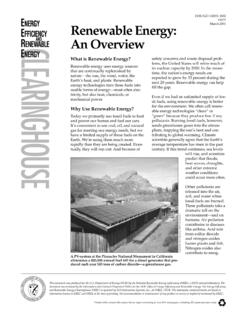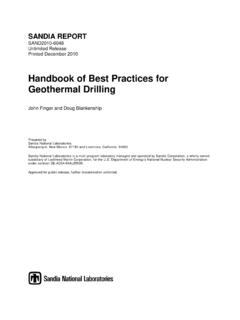Transcription of RENEWABLE ENERGY SOURCES
1 1 RENEWABLE ENERGY SOURCES Antonia V. Herzog Timothy E. Lipman Daniel M. Kammen ENERGY and Resources Group RENEWABLE and Appropriate ENERGY Laboratory (RAEL) University of California, Berkeley, USA Email: URL: ~rael Keywords: RENEWABLE ENERGY , Bioenergy, Photovoltaics, Solar ENERGY , Geothermal ENERGY , Hydropower, Wind ENERGY , Climate Change, Clean ENERGY Technologies, Learning Curve, Market Transformation Program, ENERGY Forecasts This report is to be published in the Encyclopedia of Life Support Systems (EOLSS) Forerunner Volume Perspectives and Overview of Life Support Systems and Sustainable Development, Part 4C. ENERGY Resource Science and Technology Issues in Sustainable Development RENEWABLE ENERGY SOURCES , and can be found at: 2 Contents Glossary Summary 1. Introduction 2. Biomass ENERGY Introduction The Future Role of Biomass Biomass ENERGY Conversion Technologies and Applications Combustion Gasification Anaerobic Digestion Liquid Biofuels Implementation of Biomass ENERGY Systems Biomass Resources Environmental Impacts and Benefits Economic and Production Issues Conclusions 3.
2 Wind ENERGY Introduction Economics of Wind ENERGY Potential for Wind ENERGY : Technical, Resource and Environmental Issues Selected Country Profiles and Government Incentives to Promote Wind ENERGY United States Germany Denmark Spain Great Britain Developing Countries Conclusions 4. Solar Photovoltaic and Solar Thermal Technologies Solar Photovoltaics Solar Thermal Systems 5. Hydropower Introduction Capacity and Potential Small Hydro Environmental and Social Impacts Conclusions 6. Geothermal ENERGY Introduction Capacity and Potential Environmental Impacts Conclusions 7. RENEWABLE ENERGY System Cost and Performance Recent progress in RENEWABLE ENERGY System Cost and Performance 3 Lessons Learned in Developing Countries Leveling the Playing Field Public and Private Sector Investment Issues 8.
3 Conclusions Acknowledgments Bibliography Author Biographies 4 Glossary Amorphous silicon (a-Si): A glassy alloy of silicon and hydrogen (about 10 percent) used in thin-film photovoltaic solar cells to convert sunlight to electricity. Anaerobic Digestion: Combustible gas called biogas produced from biomass through low temperature biological processes. Anthropogenic: Man made. Bagasse: The fiber residue that remains after juice extraction from sugarcane. Baseload: That part of total ENERGY demand that does not vary over a given period of time. Biodiversity: In the most general sense, all aspects of variety in the living world: the richness of living forms ranging from genes and molecules to entire ecosystems, forms and structures. Bioenergy: The conversion of biomass into useful forms of ENERGY such as heat, electricity and liquid fuels. Benefit-cost ratio (BCR): A ratio of estimates of the long-term benefits and costs from an economic decision, typically discounted to net present values.
4 Biogas: The common name for a gas produced by the biological process of anaerobic (without air) digestion of organic material. Biomass: Organic, non-fossil material of biological origin constituting an exploitable ENERGY source. Capital costs: Costs associated with the capital or investment expenditures on land, plant, equipment and inventories. Unlike labor and operating costs these are independent of the level of output. Carbon Dioxide (CO2): The gas formed in the ordinary combustion of carbon, given out in the breathing of animals, burning of fossil fuels, etc. Human SOURCES are very small in relation to the natural cycle. Carbon tax: A tax based on the carbon content of a fuel so as to internalize environmental externalities associated with climate change. Clean ENERGY Technologies (CET): Electricity and/or heat producing systems that produce negligible or minimal amounts of environmental pollution compared with conventional technologies. Climate change: A change in climate, which is attributed directly, or indirectly to human activity that alters the composition of the global atmosphere and is in addition to natural climate variability observed over comparable time periods.
5 Combined heat and power (CHP), or cogeneration systems: The waste heat from a steam turbine producing electricity is recovered and used for meeting industrial process heat needs. Commercial ENERGY : ENERGY supplied on commercial terms. Distinguished from non-commercial ENERGY comprising fuelwood, agricultural wastes and animal dung collected usually by the user. Dematerialization: ENERGY conservation, less new ENERGY needed for future economic growth. Discount rate: The annual rate at which the value of future costs is reduced so as to be comparable to the value of present costs. DOE: Department of ENERGY . Economies of scale: Reductions in manufacturing costs that accrue through increases in the scale of production and the resulting efficiencies in production. Emission permit: A non-transferable or tradable allocation of entitlements by a government to an individual firm to emit a certain amount of a substance. 5 ENERGY crops: Crops designed either exclusively for a biomass ENERGY feedstock or for the coproduction of ENERGY and other agricultural products.
6 Environmental costs: real economic costs to society, borne through damages or alterations to an environmental medium. EPA: Environmental Protection Agency, a US government agency. Ethanol: Clean burning high efficiency fuel produced from the fermentation of biomass that can substitute for conventional liquid petroleum fuels such as gasoline and kerosene. Exajoules (EJ): 1018 joules, a unit of measurement of ENERGY , which is the capacity for doing work. Experience curve: A curve that plots the reduction in unit manufacturing cost of a given product, typically as a function of accumulated production. Similar to a progress ratio, but typically at the industry level rather than the individual firm level. Externalities: By-products of activities that affect the well being of people or damage the environment, where those impacts are not reflected in market prices. Fischer-Tropsch (F - T) liquids: A class of synthesized hydrocarbons, which is a petroleum-like liquid fuel, produced from gasified biomass.
7 Fluidized beds: Beds of burning fuel and non-combustible particles kept in suspension by upward flow of combustion air through the bed. Limestone or coal ash are widely used non-combustible materials. Forward-price: A strategy for pricing whereby the initial price is set below total manufacturing cost in order to capture market share and economies of scale so that the manufacturing cost drops below the price and the initial losses can be recouped. Fossil fuels: A device that produces electricity directly from chemical reactions in a galvanic cell wherein the reactants are replenished. Gasification: Combustible gas called producer-gas produced from biomass through a high temperature thermochemical process. Involves burning biomass without sufficient air for full combustion, but with enough air to convert the solid biomass into a gaseous fuel. Geothermal: Natural heat extracted from the earth's crust using its vertical thermal gradient, most readily available where there is a discontinuity in the earth's crust ( where there is separation or erosion of tectonic plates).
8 Greenhouse gas (GHG): Gases which, when concentrated in the atmosphere, prevent solar radiation trapped by the Earth and re-emitted from its surface from escaping. The result is a rise in the Earth s near surface temperature. The phenomenon was first described by Fourier in 1827, and first termed the greenhouse effect by Arrhenius in 1896. Carbon dioxide is the largest in volume of the greenhouse gases. The others are halocarbons, methane (CH4), nitrous oxide (N2O), ozone (O3), hydrofluorocarbons, perfluorocarbons, and sulphur hexafluoride. Integrated gasification combined cycle (IGCC): An IGCC system involves sizing and drying of the feedstock, followed by thermochemical gasification to produce a combustible gas, cooling and cleaning of the gas, and combustion in a gas turbine. Steam is raised using the hot exhaust of the gas turbine to drive a steam turbine that generates additional power and/or delivers lower pressure steam for heating purposes. The cascading of a gas turbine and a steam turbine in this manner is commonly called a combined cycle.
9 Intermittent RENEWABLE : A RENEWABLE ENERGY system that operates periodically rather than constantly, such as when the sun is shining or wind is blowing. Kilowatthour (kWh): A unit of measure of ENERGY (1kWh = x 106 J). 6 Kyoto Protocol: An international treaty created in 1997 in Kyoto, Japan to reduce industrial nation s global emissions of greenhouse gases. Thirty-nine countries listed in Annex B to the Kyoto Protocol indicated agreement at this Third Conference of the Parties (COP) to the UN Climate Change Convention (UNFCCC) to contemplate legally binding quantified emission limitation and reduction commitments. The Kyoto Protocol has not yet been ratified. Levelized cost: A constant periodic stream of costs that when discounted equals the discounted actual varying stream of periodic costs associated with the installation and operation of a given technological system. Life cycle analysis (LCA): Evaluation of a technology or technological system including all stages of its production, installation, operation, and decommissioning, and all associated inputs to these stages.
10 May include evaluation of life cycle costs, life cycle emissions, or both, and may be complete (following the above definition), or partial. Marginal cost: The additional cost incurred by producing one more unit of output. Market barriers: Conditions that prevent or impede the diffusion of cost-effective technologies or practices. Market Transformation Program: A program to alter or accelerate the evolution or growth of a market, typically for a new technology, and often by the use of production or other subsidies in the short run that are intended to build future market strength, size, or diversity. Methane (CH4): A gas emitted from coal seams, natural wetlands, rice paddies, enteric fermentation (gases emitted by ruminant animals), biomass burning, anaerobic decay or organic wastes in landfill sites, gas drilling and venting, and the activities of termites. MSW: Municipal solid waste. OECD: Organization for Economic Cooperation and Development, an organization of mainly free-market industrialized countries setup to assist member states to develop economic and social policies to promote sustained economic growth with financial stability.





